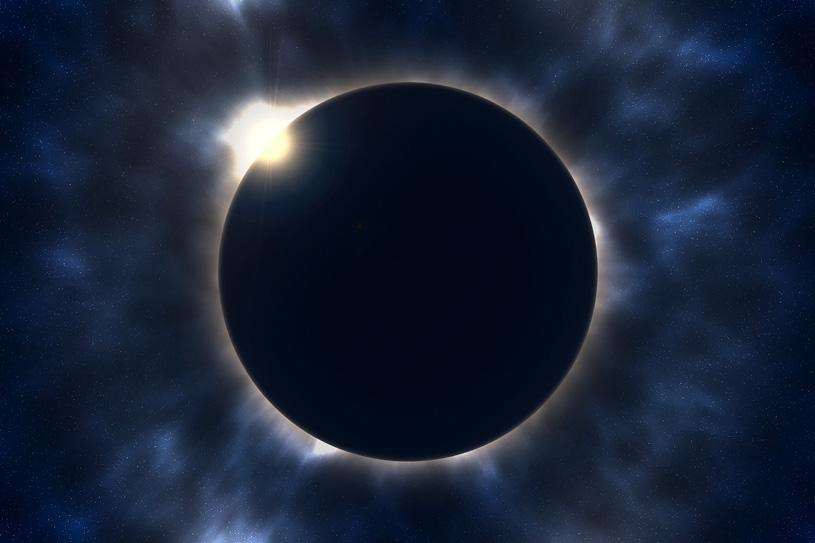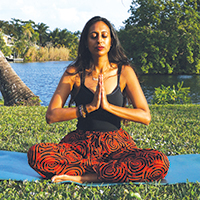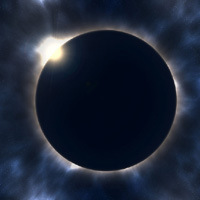Embracing Shadows: Ancient Wisdom and Modern Practices During Solar Eclipses
By Chahna Tailor Gupta

A solar eclipse, where the moon passes between the Earth and the sun, obscuring the sun’s light, has always fascinated and alarmed civilizations across the world. Traditionally, in Jyotish (Vedic astrology) and Ayurveda—ancient Indian systems of astrology and medicine—eclipses are seen as significant yet potentially disruptive cosmic events. This April’s solar eclipse provides a timely opportunity to explore these ancient interpretations alongside today’s scientific understanding.
According to Jyotish, an eclipse disrupts natural energies, as the sun, which represents the soul, health, and vitality, and the moon, which influences emotions and the mind, are obscured. This celestial event is seen as a time of misalignment and imbalance, impacting both the environment and individual well-being. Eclipses are believed to be caused by Rahu and Ketu, the north and south lunar nodes, considered shadow planets associated with karmic retribution. Their prominence during an eclipse is thought to amplify potential chaos and disturbances.
“Ayurveda also views eclipses as a time when the balance of bodily energies, or doshas, is susceptible to disruption. The irregular light and altered environmental conditions are said to affect digestive and mental health. “
As a result, activities such as eating and sleeping are discouraged during an eclipse to prevent health disturbances.
Moreover, the psychological effects of the unusual natural phenomenon—an ominous appearance and unsettling ambiance—contribute to a sense of unease. Both Jyotish and Ayurvedic traditions recommend engaging in purification rituals such as chanting mantras, meditating, fasting, and bathing in sacred rivers post-eclipse. These practices aim to restore the spiritual and physical balance disrupted by the eclipse.
The lack of proper eye protection in ancient times may also have contributed to the perception of eclipses as dangerous events. Direct observation without modern solar eclipse glasses could lead to retinal burns, reinforcing the idea of inherent risks. Today, however, with the advent of specially designed solar eclipse glasses that filter harmful rays, viewing these celestial events has become safe and educational. These glasses allow us to experience the awe of eclipses without the fear historically associated with them.
Their methodologies, involving detailed record-keeping, observation, and predictive analyses, demonstrate a structured approach to understanding human-environment interactions, which parallels scientific inquiry. However, it’s important to differentiate their metaphysical and spiritual interpretations from strictly empirical scientific disciplines. Their blend of empirical observation with spiritual and holistic wellness practices represents a unique intersection of science with traditional wisdom. This protective gear bridges the gap between intriguing ancient customs and modern scientific understanding. Both eras share a common thread—a deep respect and awe for the mysteries of the cosmos. Whether through ritual or science, the solar eclipse remains a profound symbol of human connection to the universe, illustrating how cultural interpretations can evolve alongside technological advancements. How did you spend your time on the day of the solar eclipse?
About the Author
 Chahna Tailor Gupta, an Ayurvedic Practitioner and certified yoga teacher, has a background in occupational therapy and health science with a focus in public health. Chahna was yoga trained in Rishikesh, India and had ayurvedic clinicals in Kannur, Kerala. Chahna provides yoga, pranayama, meditation, 200-hr yoga teacher training, and ayurvedic health counseling services through her company Namaskar To You. Chahna is a volunteer for Ekal Vidyalaya, American Association of Ayurvedic Professionals (AAAP), and Ayurveda Association of Florida (AAF). She is currently pursuing a doctoral degree in Ayurvedic Medicine while continuing her self-studies in yoga.
Chahna Tailor Gupta, an Ayurvedic Practitioner and certified yoga teacher, has a background in occupational therapy and health science with a focus in public health. Chahna was yoga trained in Rishikesh, India and had ayurvedic clinicals in Kannur, Kerala. Chahna provides yoga, pranayama, meditation, 200-hr yoga teacher training, and ayurvedic health counseling services through her company Namaskar To You. Chahna is a volunteer for Ekal Vidyalaya, American Association of Ayurvedic Professionals (AAAP), and Ayurveda Association of Florida (AAF). She is currently pursuing a doctoral degree in Ayurvedic Medicine while continuing her self-studies in yoga.























